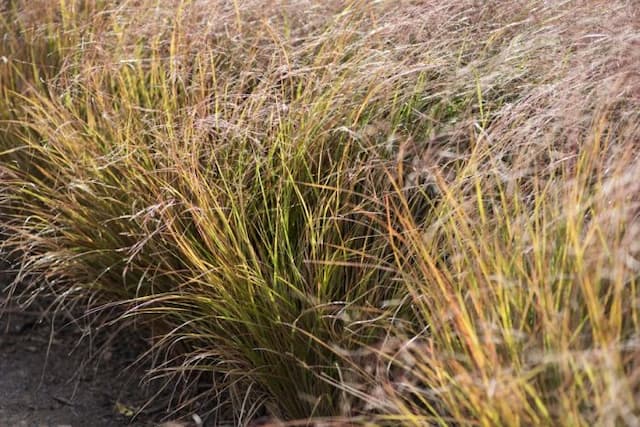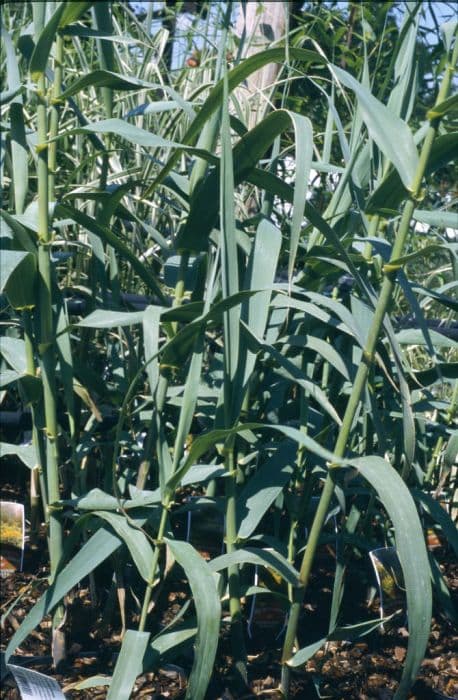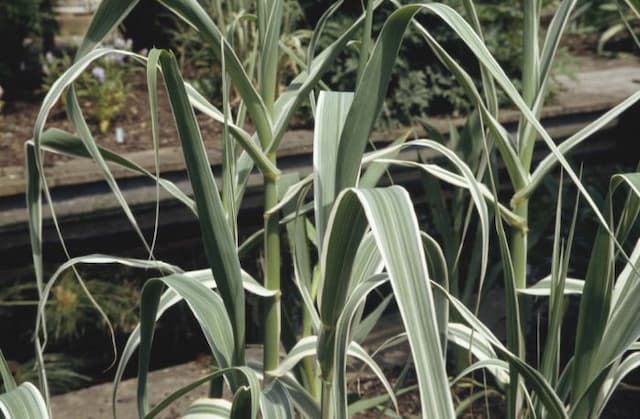Variegated Common Reed Phragmites australis subsp. australis 'Variegatus' (v)

ABOUT
Phragmites australis subsp. australis 'Variegatus,' more commonly known as the variegated common reed, is a striking ornamental grass that boasts distinctive visual features. The most prominent characteristic of this reed is its foliage pattern; the long, narrow leaves are elegantly striped with creamy white and green, creating a lush, variegated appearance that can add both texture and a subtle color contrast to any setting in which it is placed. As the leaves rustle and sway in the wind, the variegated patterns create a dynamic visual spectacle that can be quite captivating. Adding to its decorative appeal, during certain periods, the variegated common reed produces feathery flower plumes that emerge tinted with purplish hues, gradually fading to a soft, silvery-gray as they mature. These plumes are held aloft on sturdy stems that rise above the body of the grass, catching the eye and providing an additional layer of textural interest. The plumes can persist well into the cooler seasons, often contributing structural beauty to a garden even when much else has succumbed to frost. The contrast between the creamy variegation of the leaves and the muted tones of the flower plumes makes this plant a popular choice for ornamental uses. Overall, the variegated common reed presents a lush, multi-seasonal display of variegated foliage and attractive plumes, making it a visually appealing addition to a variety of landscapes. Its appearance can enrich a garden with both movement and elegance, merging visual interest with a touch of natural whimsy.
About this plant
 Names
NamesSynonyms
Variegated Reed, Variegated Common Reed, Ribbon Grass, Striped Reed.
Common names
Arundo phragmites L., Phragmites communis Trin., Phragmites phragmites (L.) Karst., Arundo phragmites var. berlandieri (E.Fourn.) Fernald, Phragmites communis subsp. berlandieri (E.Fourn.) Celarier & Harms.
 Toxicity
ToxicityTo humans
Variegated Reed Grass (Phragmites australis subsp. australis 'Variegatus') is not commonly known to be toxic to humans. If ingested, there is generally no concern for poisoning or toxic effects solely due to this plant. Therefore, no specific symptoms of poisoning from Variegated Reed Grass are typically expected. However, it is always recommended to avoid eating parts of ornamental plants due to the potential presence of other harmful substances such as pesticides.
To pets
Variegated Reed Grass is not known to be poisonous to pets. As with humans, ingestion of this plant is not commonly associated with toxic effects or symptoms of poisoning in pets. Despite its non-toxic status, ingestion of large quantities of plant material could lead to gastrointestinal upset or blockage, especially in smaller pets. Owners are advised to prevent pets from chewing on ornamental plants to avoid these potential non-toxic related issues.
 Characteristics
CharacteristicsLife cycle
Perennials
Foliage type
Deciduous
Color of leaves
Variegated
Flower color
Varies
Height
6 feet (1.8 meters)
Spread
3 feet (0.9 meters)
Plant type
Herb
Hardiness zones
4
Native area
Eurasia
Benefits
 General Benefits
General Benefits- Erosion control: 'Variegatus' helps stabilize soil with its robust root system, preventing soil erosion especially near water bodies.
- Habitat for wildlife: Provides shelter and nesting areas for birds and other wildlife species.
- Aesthetic appeal: 'Variegatus' has attractive variegated foliage that enhances garden landscapes and natural settings.
- Privacy screen: Its tall and dense growth habit makes it an effective natural screen for privacy.
- Noise reduction: The dense stands of 'Variegatus' can help mitigate noise pollution.
- Windbreak: Can serve as a barrier against strong winds, protecting smaller plants and reducing wind erosion.
- Bioenergy source: Has potential as a renewable energy source as biomass for biofuel production.
- Phytoremediation: 'Variegatus' can absorb contaminants from soil and water, aiding in environmental cleanup efforts.
- Wastewater treatment: It can be used in constructed wetlands for the treatment of wastewater.
- Carbon sequestration: Like other plants, 'Variegatus' captures carbon dioxide, contributing to carbon sequestration efforts.
- Adaptability: Tolerant of a variety of soil conditions, which makes it a versatile plant for different landscapes.
 Medical Properties
Medical PropertiesThis plant is not used for medical purposes.
 Air-purifying Qualities
Air-purifying QualitiesThis plant is not specifically known for air purifying qualities.
 Other Uses
Other Uses- Phragmites, also known as the common reed, has been used traditionally in thatching for roofing due to its water resistance and insulating properties.
- Its tall and sturdy stalks can be used for weaving baskets, mats, and other handicrafts, offering both flexibility and strength.
- In some regions, the common reed is utilized in the construction of windbreaks or privacy screens, as it can grow densely and quite tall.
- The plant has been used in the fabrication of musical instruments such as reed pipes and flutes, where its hollow stems are ideal for sound production.
- Farmers have employed common reed stems as support stakes for other crops, like tomatoes and beans, due to their robustness and easy availability.
- Its extensive root system is effective in soil stabilization and can be used to prevent erosion on riverbanks or in wetland areas.
- Processed fibers from Phragmites can be incorporated into paper-making, providing a sustainable source of material for artisanal paper products.
- In some cultural ceremonies and traditional dances, the reed is used to create masks, costumes, and decorative elements because of its versatility in crafting.
- Common reed has been employed in landscaping due to its ornamental appearance, particularly the variegated forms that add visual interest to garden settings.
- It has potential in bioenergy production, as research has been looking into the use of Phragmites as a feedstock for biofuel due to its rapid growth rate and high biomass yield.
Interesting Facts
 Feng Shui
Feng ShuiThe Common Reed is not used in Feng Shui practice.
 Zodiac Sign Compitability
Zodiac Sign CompitabilityThe Common Reed is not used in astrology practice.
 Plant Symbolism
Plant Symbolism- Adaptability: Common Reed (Phragmites australis) represents adaptability, as it thrives in a variety of environmental conditions, from wetlands to dry soils.
- Resilience: Its ability to grow quickly and recover from disturbances symbolizes resilience and the capacity to bounce back from challenges.
- Invasiveness: Often seen as an invasive species, the Common Reed can symbolize the consequences of unchecked growth and the importance of balance with native ecosystems.
- Purification: Since reeds naturally filter water and improve water quality, they symbolize cleansing and purification.
- Protection: In some cultures, reeds are associated with protection because they provide habitat and shelter for wildlife.
 Water
WaterThe Variegated Reed Grass should be watered thoroughly, ensuring that the soil is moist but not waterlogged. It thrives in wet conditions, so regular watering is essential, especially during dry spells. Depending on temperature and humidity, watering may need to occur as often as once or twice a week, providing approximately 1-2 gallons of water each time. During winter months, reduce the watering frequency to match the plant's reduced growth and evapotranspiration rates.
 Light
LightVariegated Reed Grass prefers full sun to partial shade, so it should be planted in a spot where it will receive at least six hours of direct sunlight each day. It can tolerate some light shade but will perform best and develop the strongest variegation with adequate sunlight. Avoid deep shade locations as this can result in weak growth and less vigorous variegation.
 Temperature
TemperatureVariegated Reed Grass is hardy and can tolerate a wide range of temperatures, typically thriving in conditions between 40 to 90 degrees Fahrenheit. It will survive temperatures as low as 20 degrees Fahrenheit but may suffer if the temperature drops further. The plant enjoys warm summers but does not require excessively high temperatures to grow optimally.
 Pruning
PruningPrune Variegated Reed Grass primarily to remove dead or damaged leaves and to maintain its shape. The best time to prune is in late winter or early spring, before new growth begins. Pruning can be done annually, cutting the grass back to about 6-8 inches to encourage fresh, vigorous shoots.
 Cleaning
CleaningAs needed
 Soil
SoilThe best soil mix for Variegated Reed Grass should be rich, consistently moist, and well-draining, with a slightly acidic to neutral pH around 5.5 to 7. It can thrive in loamy, sandy, or clay soils, as long as the moisture conditions are maintained.
 Repotting
RepottingVariegated Reed Grass, being a vigorous grower, should be repotted or divided every 2-3 years to manage its growth and prevent it from becoming root-bound.
 Humidity & Misting
Humidity & MistingVariegated Reed Grass prefers high humidity levels but is adaptable and can tolerate a range of humidity conditions as long as it has adequate moisture at its roots.
 Suitable locations
Suitable locationsIndoor
Place in bright light, keep soil moist.
Outdoor
Full sun to partial shade, keep moist.
Hardiness zone
4-9 USDA
 Life cycle
Life cycleThe life of the Variegated Common Reed, Phragmites australis subsp. australis 'Variegatus', begins with seed germination, which usually occurs in wetland conditions with ample water supply and sunlight. Once the seed germinates, a young shoot emerges and establishes a root system, with the plant preferring damp or even shallow submerged environments. As the plant matures, it develops tall, sturdy stems with variegated leaves that are striped with white and green, and it forms dense clumps through rhizomatous growth. During the summer, the reed produces feathery flower plumes that can be purple to brown in color, leading to wind-pollination. After pollination, seeds form and are dispersed, often by water or wind, to begin a new cycle. In temperate zones, the plant dies back in winter but the rhizomes survive, regenerating new shoots in the spring.
 Propogation
PropogationPropogation time
Spring to summer
The most common method of propagation for Variegated Reed (Phragmites australis subsp. australis 'Variegatus') is through division. This is typically done in the spring, just before the growing season begins, to give the divided plants time to establish themselves. To propagate by division, carefully dig up a portion of the established plant, ensuring there is a good section of roots attached. Using a sharp shovel or knife, divide the root mass into smaller clumps, each with several shoots. Afterwards, immediately replant the new divisions at the same depth they were originally growing, spacing them about 2 to 3 feet (approximately 60 to 90 centimeters) apart to allow room for growth. Water the new divisions thoroughly to help establish the root system. With this method, the variegated foliage pattern will be reliably reproduced in the new plants.









